
 Equipment for placer mining is generally divided into two groups...
Equipment for placer mining is generally divided into two groups...
Of course, placer miners also use camping/outdoors equipment.
Very large mines might use other kinds of equipment, such as draglines or bucket-wheel excavators. This website isn't really for the folks putting together that kind of mine.
For more information on digging, see the Excavation page.
All placer processing has some basic steps...
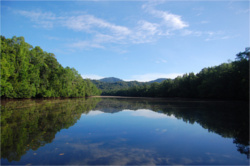 A "cobble" is basically anything bigger than a piece of gravel
and smaller than a boulder.
A "cobble" is basically anything bigger than a piece of gravel
and smaller than a boulder.
How they are handled depends on the operation. In a hand operation, some cobbles may be picked up and washed (often by dipping them into a pail of water), but all operations have some size limit above which the only processing a piece gets is being shifted out of the way (and maybe being washed off).
In a machine-digging operation (with an excavator), a heavy grizzly is used - a heavy-duty grate at a fairly steep angle (30 to 50 degrees) with gaps between the bars ranging from maybe 2 to 6 inches. Pieces that are too large to pass between the bars roll or slide off. One or more spray bars may be used to wash fine material off oversize pieces and to help the sliding. Railway rails (upside down) can be used as bars in a heavy grizzly.
When using a grizzly, from time to time it is necessary
for feeding to stop and for someone to climb up there with a
hammer and remove pieces of rock that are jammed between the
bars. This might happen multiple times per day to multiple
times per hour, depending on the material.

A sluice box with attached grizzly, and some sort of spray-bar with a fitting for a water hose, is often called a high banker or highbanker.
For machine-digging operations, there are primarily two kinds of equipment used to remove cobbles and gravel above some size...
The most common is a trommel. The blue one to the right is fairly small; a medium sized trommel might have a barrel between 2 and 3 feet across and 10 to 15 feet long. Material that passes through the grizzly enters the upper end of a rotating steel cylinder (called a barrel or drum) at a moderate angle. The barrel is perforated for part of its length - holes might be one half to one inch across. A serious spray bar runs down the center of the barrel. Steel plate a few inches wide runs lengthwise inside the barrel to lift and then drop material as the barrel rotates (like in a clothes dryer). Because the barrel is at an angle, material is dropped a little lower than where it was picked up. Anything that makes its way through the holes is directed into a sluice box or jigs. Material that makes it to the end of the barrel is discarded. Because the contents are dropped repeatedly with water, trommels are good at breaking up clay.
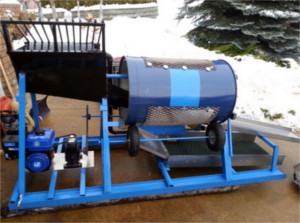 An alternative to a trommel is a screening plant that uses
screens at a moderate angle that shake or vibrate with
water sprayed from above. Often, multiple screens are used,
each finer than the one above it (which prevents large material
from damaging a light-duty screen). The bottom screen might have
spaces that are one quarter to one inch across. Anything that rolls
or slides off the screens is discarded. Anything that makes it
through the screens is directed to a
sluice box or jigs.
An alternative to a trommel is a screening plant that uses
screens at a moderate angle that shake or vibrate with
water sprayed from above. Often, multiple screens are used,
each finer than the one above it (which prevents large material
from damaging a light-duty screen). The bottom screen might have
spaces that are one quarter to one inch across. Anything that rolls
or slides off the screens is discarded. Anything that makes it
through the screens is directed to a
sluice box or jigs.
Screening does not work well if the material contains much clay. In addition, screens get "blinded" (all the holes filled with something that won't go through), which isn't much of a problem with trommels (because of all the dropping and hammering that goes on inside the trommel barrel).
Generally, any way of separating gold from the remaining material will
also separate out some "black sand" and maybe a little regular sand.
This mixture is called "concentrates".
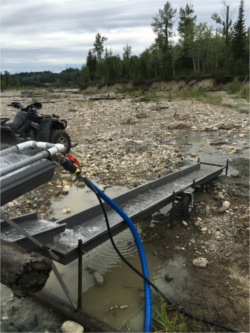
Using multiple sluice boxes can increase the recovery of fine gold.
A sluice box should not be rigidly attached to a
trommel or screening plant; ideally it should not be physically
attached at all. You don't want vibrations from boulders
hitting the grizzly or cobbles tumbling inside a trommel to shake gold
out from where it has been captured in the sluice.
Small amounts of concentrates can be separated by
hand panning.
Black sand generally includes magnetite, which is magnetic. Using a
magnet directly is frustrating because the particles are difficult to
remove from the magnet. Inexpensive devices can be used that move a
magnet to and away from the end so you can pick up the magnetic sand
and then drop it elsewhere. You can accomplish the same thing with a
magnet and plastic from a plastic bag.
If concentrates are high in magnetic sand, some gold can be trapped
between grains of magnetic sand and be removed as well. This can be
seen if the magnetic sand is released in a jar of water. The solution
to the problem is to do the magnetic separation twice, ideally from
concentrates that are in water.
Another type of sluice for concentrates is made from a piece of
corrugated plastic drain pipe 4 to 6 inches across and 6 to 8
feet long. The pipe is cut in half length-wise and one half is
screwed to a plank open side up. At the top, an arrangement for
a garden hose might be used to supply a gentle flow of water.
If the flow and angle are just right, almost all the gold will be
caught in the first few corrugations. This sort of sluice may also
be used in the field with a small (probably 12-volt) pump to supply
water. Concentrates might be fed into the top end of the sluice with
a spoon.
Gold spirals, are effective and they are available in a wide
range of sizes, from about 18 inches across to 6 feet across.
Details vary, but the general idea is that concentrates are fed onto
a flat, tilted, slowly rotating disk near the top. The disk has a ridge
or groove that spirals around many times, ending up at a hole in the
center. Water flows over the disk, carrying away lighter material, while
the gold is carried by the spiral, eventually falling into the hole
through the center.
There are a variety of bowl separators of different sizes.
I believe these devices are mostly for small amounts of concentrates -
that is, up to cups, not pails. They swirl the material around the
inside of a bowl using a flow of water. The lightest material moves
furthest from the heavy gold. The "Blue Bowl" has a good reputation.
Shaker tables or shaking tables are very effective and
are also available in a wide range of sizes. They are generally
rectangular and tilted so that one long side is lower than the other.
Small ridges run across part or all of the table. Water flows from
the top edge of the table down over the ridges and off the lower edge.
A slurry of the material in water steadily flows onto the top right
corner of the table. The table repeatedly moves a little to the left
and then snaps back to the starting position. Lighter material tends
to be carried down the table, over the ridges and off the lower edge
by the flow of water. Black sand, being heavier, doesn't move over
the ridges as much and tends to move more diagonally towards and off
the lower left corner. Gold moves mostly horizontally due to the
ridges and the snap-back motion, and moves off the top half of the
left side of the table.
All images on this website are copyrighted by their owners and
they may not be downloaded for other than personal
use - republication, retransmission, reproduction or other use is
prohibited.
Note: This page may contain images from FREEBigPictures.com.
INFORMATION PROVIDED BY THIS WEBSITE IS PROVIDED "AS IS",
WITHOUT WARRANTY OF ANY KIND, EXPRESS OR IMPLIED, INCLUDING BUT NOT
LIMITED TO THE WARRANTIES OF ACCURACY, MERCHANTABILITY,
FITNESS FOR A PARTICULAR PURPOSE AND NON-INFRINGEMENT.
USE AT YOUR OWN RISK.
Jigs
Jigs can be used with or instead of sluice boxes. Water and
gold-bearing material flow across a box containing "ragging" -
usually small steel balls. An arrangement in the bottom part of
the box alternately pushes up and sucks down the water in the jig.
Compared to lighter material, gold and other heavy minerals tend
to move down more, and up less, than lighter material. Lighter material
tends to flow across and off the top of the jig. Concentrates work
their way down and out the bottom. Jigs are often used in pairs, with
the material that flows off the first one falling a short distance onto
the top of the second. Jigs are used by some mines, but they are
expensive and because they have moving parts, they can break down. They
may have to be adjusted when the material size or flow of water changes.
They are not good at catching very fine gold or nuggets, but a
nugget sluice upstream of the jigs can fix the second problem.
Equipment for Separating Gold from Concentrates
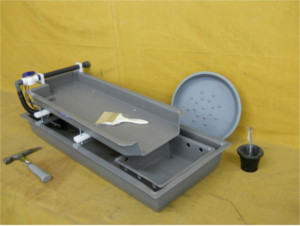 Extracting gold from concentrates (gold, black sand and some regular
sand) can be done in the field or concentrates can be shipped home and
processed during the cold months when mining can't be done.
Extracting gold from concentrates (gold, black sand and some regular
sand) can be done in the field or concentrates can be shipped home and
processed during the cold months when mining can't be done.
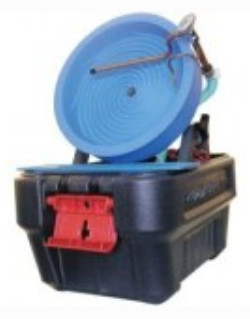 A special purpose Sluice Box sluice box can be used to separate
gold from black sand. This sort of sluice should have no regular
riffles. Only ribbed rubber floor matting should be on the bottom,
preferably of a color that makes it easy to see black sand and gold.
The ribs run across the box. Doing the separation is a matter of
adjusting angle and water flow to separate the black sand from the much
denser gold.
A special purpose Sluice Box sluice box can be used to separate
gold from black sand. This sort of sluice should have no regular
riffles. Only ribbed rubber floor matting should be on the bottom,
preferably of a color that makes it easy to see black sand and gold.
The ribs run across the box. Doing the separation is a matter of
adjusting angle and water flow to separate the black sand from the much
denser gold.
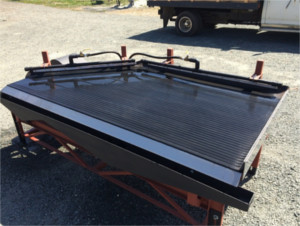
Notices
Copyright 2011 to 2024 by Brian Marshall
Copyright 2024 by The Omineca Mining Association